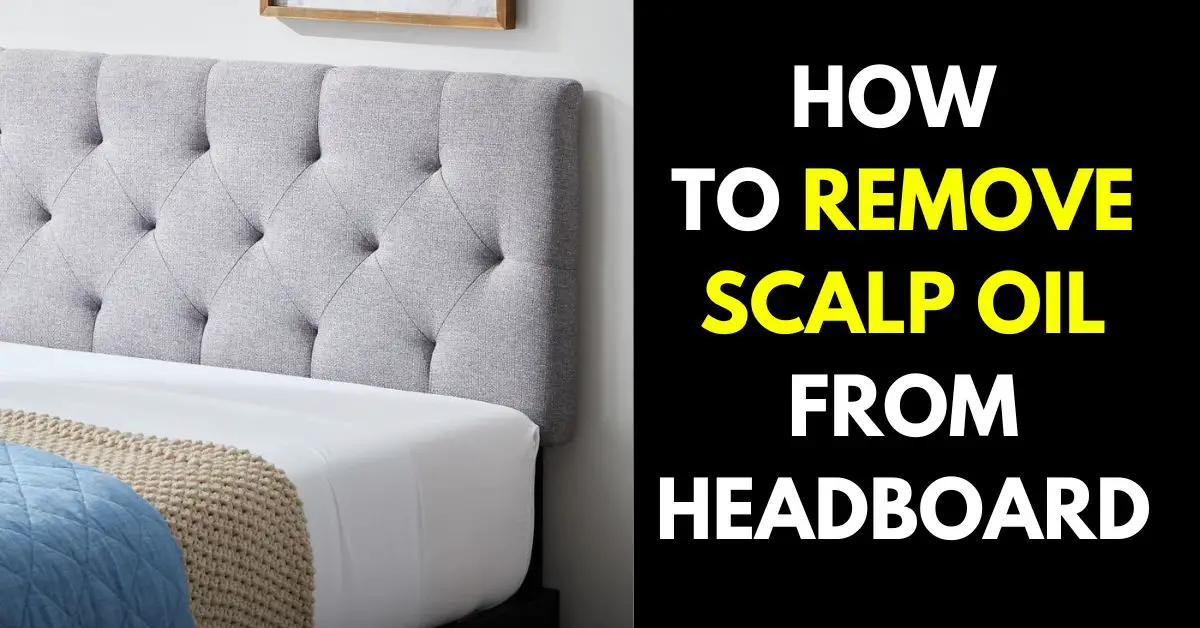
We all know how important it is to take care of our hair and scalp. The natural oils produced by our skin and scalp help keep them moisturized, preventing dryness and cracking. However, when these oils come in contact with upholstered furniture, they can leave an unsightly, greasy stain that’s tough to remove. If you’ve ever dealt with oily scalp stains on your headboard or other upholstered furniture, you know how frustrating it can be. Fortunately, there are several effective home remedies you can use to remove scalp oil from headboard without resorting to harsh chemicals or expensive commercial products.
In this guide, we’ll discuss some easy and effective ways to get rid of those stubborn stains and restore your furniture to its former glory. So let’s get started
What is a Fabric Headboard?
A fabric headboard is a type of headboard that is covered in fabric material. It is typically attached to the bed frame and provides a supportive backrest for sitting up in bed. Fabric headboards come in a variety of shapes, sizes, and styles to fit different bed frames and bedroom decor.
They are usually filled with foam or other padding materials to provide extra comfort and support. Fabric headboards can be made from a wide range of fabrics, including cotton, linen, velvet, and microfiber.
They may also feature decorative elements such as tufting, buttons, or nailhead trim to add a touch of style to the bedroom. Overall, a fabric headboard is a great way to enhance the look and feel of your bedroom while providing extra comfort and support.
Do Fabric Headboards Get Dirty Easily?
Fabric headboards can accumulate dirt and stains over time, just like any upholstered furniture. However, how easily they get dirty depends on a variety of factors such as the color and material of the fabric, how frequently the headboard is used, and how well it is cared for.
Light-colored fabrics and fabrics made from natural fibers like cotton or linen may be more prone to staining and discoloration. On the other hand, dark-colored fabrics or those made from synthetic fibers like polyester may be more resistant to stains and easier to clean.
Regular cleaning and maintenance can help keep a fabric headboard looking clean and fresh. This can involve vacuuming the headboard to remove dust and dirt, spot cleaning any stains or spills as soon as they occur, and periodically deep cleaning the headboard using a fabric cleaner or steam cleaner.
Are Fabric Headboards Hard to Clean?
Cleaning a fabric headboard may require some effort, but it is not necessarily difficult. The level of difficulty in cleaning a fabric headboard depends on the type of fabric used and the severity of the stain or dirt.
Generally, regular vacuuming and spot cleaning can help prevent the buildup of dirt and stains on a fabric headboard. Vacuuming can help remove dust and dirt from the surface of the fabric, while spot cleaning can address any spills or stains as soon as they occur.
For more stubborn stains or dirt, deep cleaning may be required. This can involve using a fabric cleaner or steam cleaner to clean the fabric thoroughly. Some fabric headboards may come with cleaning instructions or recommendations from the manufacturer, which can be helpful in determining the best cleaning method.
How to Remove Scalp Oil from Headboard
It’s only natural that your headboard comes in contact with your head and the natural scalp oils on a daily basis. As time passes, these oils can accumulate on the fabric, causing a stubborn buildup that’s challenging to get rid of. Fortunately, you can take some measures to maintain a clean headboard and prevent any long-term harm.
To remove scalp oil from a headboard, follow these simple steps:
- Apply baking soda to the affected area: Sprinkle baking soda on the oily spot on your headboard and leave it for several hours. As it sits on the surface, it will absorb any surface oils, making them easier to remove.
- Vacuum up the baking soda: Once the baking soda has had time to absorb the oils, use a vacuum to remove it. This will also help to remove any dirt or debris that may have accumulated on the surface of the headboard.
- Apply detergent and water solution to a sponge: Mix some detergent with water to create a cleaning solution, and apply it to a sponge. Work the sponge into the fabric, paying close attention to the oily spot. Be sure to blot the area dry with a cloth afterward to remove any excess moisture.
- Use a clean sponge to rinse: Dampen a clean sponge with water and use it to rinse the area thoroughly. Be sure to remove any soap residue, and then dry the area with a clean cloth.

Hi Everyone, BeYoungAholic’s aim is to help women who have lost their self-confidence because of the way they look. We will provide you tips and bits of advice on how to take care of yourself and maintain your youthful look. So, Enjoy the blog!
